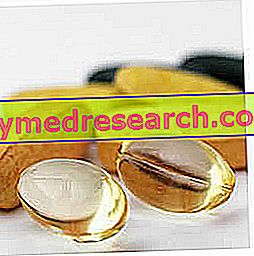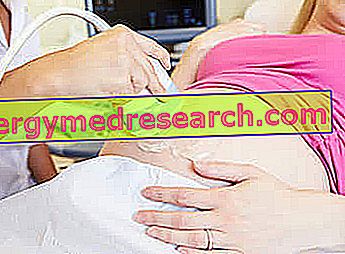Premise
The following indications are for information purposes EXCLUSIVELY and are not intended to replace the opinion of professional figures such as doctor, nutritionist or dietician, whose intervention is necessary for the prescription and composition of CUSTOMIZED food therapies.

Diet to increase muscle mass
The diet to increase mass is a diet aimed at increasing muscle hypertrophy; the diet for mass, along with training and recovery, is the only way to increase weight while maintaining a constant fat mass - Fat Mas s.
However, the diet to increase mass (and not only this ...) should NOT be UNIFORM, due to the high multiplicity of specific and subjective variables. Often, with the same diet, we are witnessing totally different metabolic reactions; therefore, with the same expenditure and with similar food schemes, certain subjects respond optimally to the stimulus while others almost for nothing! By virtue of this individual variability, many believe that the best interpretation is of the CONSTITUTIONAL type since, observing the various case studies, some anthropometric details seem to recur with a considerable frequency and correlate with the positive or negative response to the diet.
Classification of the somatotype: the endomorph
In 1940, Sheldon grouped and distinguished 3 somatotypes with specific anthropometric and behavioral characteristics; as already specified for the diet of the ectomorph, with regards to the emotional and / or sociological aspect I totally subtract myself from expressing any judgment, but on the relationship between body forms (muscle insertions, shapes of the same muscles and proportions of the bone segments) ) and response to the composition of the diet (increase in fat-free mass or reduction in fat mass) ... I admit to note that there is a certain statistical correlation.
Below we will present a case of diet to increase the muscle mass suitable for an endomorphic somatotype, or that subject characterized by: narrow shoulders and wide hips, low density body (high fat mass - tendency to fat accumulation), morphological type normolineo, musculature difficult to assess and, usually, medium hypertrophic, viscerotonic (for further information, read the article: The somatotype).
NB : What will be explained below is nothing but the result of the PERSONAL experience and does not refer in any way to research or experimental work; moreover, I recall that while highlighting some correlations between somatotype and response to the dietary regime, the essential key to achieving any goal lies in the SPECIFICITY (subjectivity) of the diet and in that of training; therefore, I invite readers who identify themselves in the example to NOT take the grammar or nutritional breakdowns of the example below too literally.
Principles of the diet for mass for endomorphs
Generally, the mass-produced bodybuilder endomorph shows one big difficulty, namely the "clean" increase of the lean mass. Maintaining a constant fat mass and increasing muscle mass, for an ectomorph, means adopting a STEP food strategy; it starts with a NORMO-caloric and balanced scheme (in which compliance and metabolic reactions are evaluated), and then corrected on the basis of anthropometric evidence (increase or reduction of circumferences, weight and fat pads). Personally, in dealing with the mass increase for an endomorph, I believe it is extremely important to take care of the training table; rather than feeding it, it will make the difference on the clean growth of muscle mass. As for the diet, on the other hand, it should be remembered that "probably" the hormonal stress on insulin is already autonomously effective and does not require the use of high doses of carbohydrates for the consequent anabolic activation; far from it! It will be the concern of the dietician to partially dissociate the meals in order to reduce the liposynthesis and the consequent adipose deposit, preserving in any case a good muscle amino acid up-take.
The main principles of the endomorphic diet for muscle mass are:
- TOTAL increase in energy by up to 10% compared to a normocaloric diet with a tendency to respect the lower limits of caloric expenditure
- Protein coefficient * kg of physiological weight and NOT real 1.5g (it should not be necessary to increase the protein intake compared to a balanced diet to promote hypertrophy)
- 25% lipid energy fraction
- Carbohydrate intake sufficient for training support and well distributed in the initial phase of the day
- Dissociate, if necessary, carbohydrates from proteins in afternoon and evening meals
- Breakdown of meals that enhances breakfast and mid-morning snack and decreases until dinner
NB . It may be useful, even in the mass phase, to undertake a small protocol of aerobic physical activity preparatory to the muscle definition phase.
WARNING! To avoid any misunderstanding, I intend to clarify that: if, by applying the aforementioned changes, the results hoped for in the initial programming do NOT appear concretely, it becomes necessary to identify the element hindering growth BUT, in no case, to increase carelessly (or, as often happens, by trial and error) the protein intake of the diet!
Furthermore, debunking some clichés, I remind you that the TOTAL protein intake of the diet is always calculated through the sum of ALL the dietary proteins ... and not only those with high biological value (animal origin), since also the vegetable ones (especially of cereals and legumes (but also those of fruit and vegetables) are digested and absorbed.The only limiting agents "could" be: the excess of dietary fiber, a disorder of gastric secretion called IPOchlorhydria, a deficiency (always pathological) of digestive enzymes.
I believe that there are no useful supplements in the diet for the mass of the endomorph, although it could be granted the use (justified by organizational reasons) of substitute meals.
Example
- High school student - 5th year; he trains 4 times a week with a mixed table, aerobic (20 'at the beginning and 20' at the end) and anaerobic due to the increase in hypertrophy.
| Sex | M | |||
| Age | 18 | |||
| Stature cm | 168 | |||
| Wrist circumference cm | 18.1 | |||
| Constitution | Robust | |||
| Stature / wrist | 9.3 | |||
| Morphological type | brevilineo | |||
| Weight kg | 80 | |||
| Body mass index | 28.4 | |||
| Desirable physiological body mass index | 24.9 | |||
| Desirable physiological weight kg | 70.3 | |||
| Basal kcal metabolism | 1754.3 | |||
| Coefficient of physical activity level | Light, yes aus 1.55 | |||
| Kcal energy expenditure | 2719.1 | |||
| Diet | NORMO CALORICA | 2720Kcal | ||
| Lipids | 25% | 680kcal | 75, 6g | |
| Protein | 1.5g / kg * real weight | 421, 8kcal | 105, 5g | |
| Carbohydrates | 59.5% | 1617, 3kcal | 431, 3g | |
| Breakfast | 25% | 680kcal | ||
| Snack | 5% | 136kcal | ||
| Lunch | 35% | 952kcal | ||
| Snack | 10% | 272kcal | ||
| Dinner | 25% | 680Kcal | ||
Example of mass diet for Endomorphs - Day 1
| Breakfast, about 25% kcal TOT | |||
| Boiled rice | |||
| White rice, short grain | 90g, 322.2kcal | ||
| Creamy milk flakes | 100g, 98.0kcal | ||
| Extra virgin olive oil | 15g, 135.0kcal | ||
| Wheat bread | 30g, 79.8kcal | ||
| Snack, about 5% kcal TOT | |||
| Apple, without peel | 500g, 240.0kcal | ||
| Lunch, about 35% kcal TOT | |||
| "Dense" puree of beans (without peel) with pasta | |||
| Dried beans | 90g, 279.9kcal | ||
| Dry pasta | 90g, 320.4kcal | ||
| Parmigiano | 10g, 39.2kcal | ||
| Extra virgin olive oil | 20g, 135.0kcal | ||
| Wheat bread | 30g, 79.8kcal | ||
| Snack, about 10% kcal TOT | |||
| Fruit juice | 250ml, 132, 5kcal | ||
| Rusks | 35g, 149.1kcal | ||
| Dinner, about 25% kcal TOT | |||
| Grilled pork chop | |||
| Pork chop, lean meat | 200g, 254, 0kcal | ||
| Lettuce | 200g, 18.0kcal | ||
| Extra virgin olive oil | 15g, 135.0kcal | ||
| Wheat bread | 90g, 239.4kcal | ||
Example of mass diet for Endomorphs - Day 2
| Breakfast, about 25% kcal TOT | |||
| Boiled pasta | |||
| Semolina pasta | 90g, 320.4kcal | ||
| Baked ham | 50g, 107.5kcal | ||
| Extra virgin olive oil | 15g, 135.0kcal | ||
| Wheat bread | 30g, 79.8kcal | ||
| Snack, about 5% kcal TOT | |||
| Pere | 500g, 290.0kcal | ||
| Lunch, about 35% kcal TOT | |||
| "Dense" chickpea puree (without peel) with rice | |||
| Dried chickpeas | 90g, 300.6kcal | ||
| White rice, short grain | 90g, 322.2kcal | ||
| Parmigiano | 10g, 39.2kcal | ||
| Extra virgin olive oil | 20g, 135.0kcal | ||
| Wheat bread | 30g, 79.8kcal | ||
| Snack, about 10% kcal TOT | |||
| Fruit juice | 250ml, 132, 5kcal | ||
| Rusks | 35g, 149.1kcal | ||
| Dinner, about 25% kcal TOT | |||
| Tuna steak | |||
| Fresh tuna, yellow fins | 200g, 216, 0kcal | ||
| Radicchio | 200g, 23.0kcal | ||
| Extra virgin olive oil | 15g, 135.0kcal | ||
| Wheat bread | 90g, 239.4kcal | ||
Example of mass diet for Endomorphs - Day 3
| Breakfast, about 25% kcal TOT | |||
| Boiled rice | |||
| White rice, short grain | 90g, 322.2kcal | ||
| Natural tuna, drained | 50g, 64.0kcal | ||
| Extra virgin olive oil | 15g, 135.0kcal | ||
| Wheat bread | 30g, 79.8kcal | ||
| Snack, about 5% kcal TOT | |||
| Kiwi | 400g, 244.0kcal | ||
| Lunch, about 35% kcal TOT | |||
| "Dense" puree of peas (without peel) with pasta | |||
| Dried peas | 100g, 306, 0kcal | ||
| Dry pasta | 90g, 320.4kcal | ||
| Parmigiano | 10g, 39.2kcal | ||
| Extra virgin olive oil | 20g, 135.0kcal | ||
| Wheat bread | 30g, 79.8kcal | ||
| Snack, about 10% kcal TOT | |||
| Fruit juice | 250ml, 132, 5kcal | ||
| Rusks | 35g, 149.1kcal | ||
| Dinner, about 25% kcal TOT | |||
| Fresh ricotta | |||
| Semi-skimmed milk ricotta | 200g, 276.0kcal | ||
| Rocket salad | 200g, 25.0kcal | ||
| Extra virgin olive oil | 10g, 90.0kcal | ||
| Wheat bread | 90g, 239.4kcal | ||
Example of mass diet for Endomorphs - Day 4
| Breakfast, about 25% kcal TOT | |||
| Boiled pasta | |||
| Semolina pasta | 90g, 322.2kcal | ||
| Bresaola | 60g, 105.0kcal | ||
| Extra virgin olive oil | 15g, 135.0kcal | ||
| Wheat bread | 30g, 79.8kcal | ||
| Snack, about 5% kcal TOT | |||
| oranges | 500g, 252, 0kcal | ||
| Lunch, about 35% kcal TOT | |||
| "Dense" puree of lentils (without peel) with rice | |||
| Dried lentils | 90g, 292.0kcal | ||
| White rice, short grain | 90g, 322.2kcal | ||
| Parmigiano | 10g, 39.2kcal | ||
| Extra virgin olive oil | 20g, 135.0kcal | ||
| Wheat bread | 30g, 79.8kcal | ||
| Snack, about 10% kcal TOT | |||
| Fruit juice | 250ml, 132, 5kcal | ||
| Rusks | 35g, 149.1kcal | ||
| Dinner, about 25% kcal TOT | |||
| Egg white omelet | |||
| Chicken egg whites | 450g, 216, 0kcal | ||
| Valerian | 200g, 21.0kcal | ||
| Extra virgin olive oil | 20g, 180.0kcal | ||
| Wheat bread | 90g, 239.4kcal | ||
Example of a mass diet for Endomorphs - Day 5
| Breakfast, about 25% kcal TOT | |||
| Boiled rice | |||
| White rice, short grain | 90g, 322.2kcal | ||
| Creamy milk flakes | 100g, 98.0kcal | ||
| Extra virgin olive oil | 15g, 135.0kcal | ||
| Wheat bread | 30g, 79.8kcal | ||
| Snack, about 5% kcal TOT | |||
| Apple, without peel | 500g, 240.0kcal | ||
| Lunch, about 35% kcal TOT | |||
| "Dense" puree of beans (without peel) with pasta | |||
| Dried beans | 90g, 279.9kcal | ||
| Dry pasta | 90g, 320.4kcal | ||
| Parmigiano | 10g, 39.2kcal | ||
| Extra virgin olive oil | 20g, 135.0kcal | ||
| Wheat bread | 30g, 79.8kcal | ||
| Snack, about 10% kcal TOT | |||
| Fruit juice | 250ml, 132, 5kcal | ||
| Rusks | 35g, 149.1kcal | ||
| Dinner, about 25% kcal TOT | |||
| Veal steak | |||
| Veal loin | 200g, 232.0kcal | ||
| Lettuce | 200g, 18.0kcal | ||
| Extra virgin olive oil | 15g, 135.0kcal | ||
| Wheat bread | 90g, 239.4kcal | ||
Example of a mass diet for Endomorphs - Day 6
| Breakfast, about 25% kcal TOT | |||
| Boiled pasta | |||
| Semolina pasta | 90g, 320.4kcal | ||
| Baked ham | 50g, 107.5kcal | ||
| Extra virgin olive oil | 15g, 135.0kcal | ||
| Wheat bread | 30g, 79.8kcal | ||
| Snack, about 5% kcal TOT | |||
| Pere | 500g, 290.0kcal | ||
| Lunch, about 35% kcal TOT | |||
| "Dense" chickpea puree (without peel) with rice | |||
| Dried chickpeas | 90g, 300.6kcal | ||
| White rice, short grain | 90g, 322.2kcal | ||
| Parmigiano | 10g, 39.2kcal | ||
| Extra virgin olive oil | 20g, 135.0kcal | ||
| Wheat bread | 30g, 79.8kcal | ||
| Snack, about 10% kcal TOT | |||
| Fruit juice | 250ml, 132, 5kcal | ||
| Rusks | 35g, 149.1kcal | ||
| Dinner, about 25% kcal TOT | |||
| Baked sea bass | |||
| Sea bass, various species | 200g, 194.0kcal | ||
| Radicchio | 200g, 23.0kcal | ||
| Extra virgin olive oil | 20g, 180.0kcal | ||
| Wheat bread | 90g, 239.4kcal | ||
Example of mass diet for Endomorphs - Day 7
| Breakfast, about 25% kcal TOT | |||
| Boiled rice | |||
| White rice, short grain | 90g, 322.2kcal | ||
| Natural tuna, drained | 50g, 64.0kcal | ||
| Extra virgin olive oil | 15g, 135.0kcal | ||
| Wheat bread | 30g, 79.8kcal | ||
| Snack, about 5% kcal TOT | |||
| Kiwi | 400g, 244.0kcal | ||
| Lunch, about 35% kcal TOT | |||
| "Dense" puree of peas (without peel) with pasta | |||
| Dried peas | 100g, 306, 0kcal | ||
| Dry pasta | 90g, 320.4kcal | ||
| Parmigiano | 10g, 39.2kcal | ||
| Extra virgin olive oil | 20g, 135.0kcal | ||
| Wheat bread | 30g, 79.8kcal | ||
| Snack, about 10% kcal TOT | |||
| Fruit juice | 250ml, 132, 5kcal | ||
| Rusks | 35g, 149.1kcal | ||
| Dinner, about 25% kcal TOT | |||
| Milk flakes | |||
| Creamy milk flakes | 200g, 196, 0kcal | ||
| Rocket salad | 200g, 25.0kcal | ||
| Extra virgin olive oil | 20g, 180.0kcal | ||
| Wheat bread | 90g, 239.4kcal | ||



